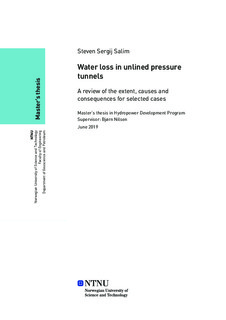| dc.description.abstract | Unlined pressure tunnel is a cost-saving method that is mostly used in designing a hydropower plant, although the application requires favorable ground condition. Initial assessment in pressure tunnel design often uses Norwegian criterion, which is widely used to provide a basis for lining design and rock cover needed for the underground infrastructure. In some cases, however, the implementation of this approach in pressure tunnel design failed to confine the water tightness and threaten the financial viability. It is compounded with unawareness of water loss from the unlined tunnel, and as consequences, it led into either ineffective design of lining, or the water resources wasted.
This thesis presents a general review on water loss from selected Norwegian hydropower case and proposes a method to assess water loss from the unlined tunnel by using a well-known concept of pressure measurement. In this study, the water loss assessment from unlined tunnel started with the development of tunnel stage-volume curve, continued with the identification of leakage source through water ingress analysis and closed with an assessment of water loss consequences from the unlined tunnel. Three main consequences of water loss are identified in this study; (1) the estimated annual financial loss can be up to 10% of the annual revenue, (2) the reduction of safety factor from the nearby slope due to the increase of groundwater pressure ranging from 10% - 30%, and (3) the increase of water consumption ranging from 7 m3/MWh – 70 m3/MWh.
Water loss review conducted in this study shows the evidence from Norwegian rule of thumb limitation. Due to ground condition uncertainty, a new method to optimize lining design by conducting pressure measurement analysis is introduced. The idea is to develop inflatable packer for interval measurement alongside the pressure tunnel. In addition, the idea to use water loss as negotiation tools to reduce environmental flow release is also discussed in this study. To achieve a better confidence level, future study to understand the behavior of water loss through the permeable zone is recommended. Moreover, a probabilistic approach is also recommended in the future to quantify uncertain factors.
Key Words: Hydropower Unlined tunnel, Tunnel leakage, Transition zone, | |
